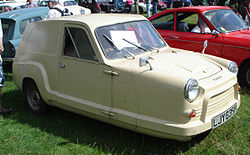Bond 875
| Bond | |
|---|---|
|
Bond Ranger (1970)
|
|
| 875 | |
| Sales designation: | 875 / Ranger |
| Production period: | 1965-1970 |
| Class : | Microcar |
| Body versions : | Limousine , panel van |
| Engines: |
Otto engines : 0.9 liters (29 kW) |
| Length: | 2946-3251 mm |
| Width: | 1397 mm |
| Height: | |
| Wheelbase : | 1981 mm |
| Empty weight : | |
| Previous model | Minicar |
| successor | Bug |

The Bond 875 is a three-wheel cars, the Bond Cars in Preston ( Lancashire built) 1965-1970. From 1967 there was also a van on the same basis called the Bond Ranger .
The 875 was announced as early as 1963. It had a four-cylinder in-line engine with 875 cm³, which was supplied by the Rootes Group . Unlike other British three-wheelers, the engine was built into the rear. It was basically the same engine as the Hillman Imp , whose transmission, rear axle, and rear wheels were also used. After the 875 had a body made of GRP and doors made of aluminum, it weighed less than 400 kg and its performance was good - better than that of the Imp. The engine was the low-compression version (8.0: 1) that the Imp Kombi called Hillman Husky and the Commer Imp van was used. It could run on the cheapest, low octane gasoline.
The low weight of the car made it taxable as a motorcycle in Great Britain. The three-wheeled car could also be driven with a motorcycle license. To keep the weight below the required limit, the interior fittings and decorations were kept extremely minimal.
Racing driver John Surtees unofficially broke the speed record for limousines at Brands Hatch with a Bond 875 when it reached 160 km / h.
development
A van version, the Ranger , was introduced in 1967.
Stylistic changes, improved seats, rectangular headlights and a larger trunk opening characterize the Mark II , which was introduced in April 1968. A heater was now also included as standard.
Data and mileage
| Parameter | Data | |
|---|---|---|
| Engine type | 4 row | |
| Displacement | 875 cc | |
| Weight | <400 kg | |
| Acceleration 0-100 km / h | limousine | 16 s |
| delivery trucks | 14 s | |
| Top speed | limousine | 129 km / h |
| delivery trucks | 153 km / h | |
| Fuel consumption | 5.1-5.6 l / 100 km | |
| tires | Michelin X Radial | |
| Factory price | £ 500 | |
Test drives
The British “Autocar” magazine tested a Bond 875 in September 1966. The car reached a top speed of 133.2 km / h and accelerated from 0 to 100 km / h in 22.5 seconds. A total fuel consumption of 8.19 l / 100 km was recorded. With these values he clearly outperformed the Morris Mini 850 in terms of top speed, acceleration and low fuel consumption. The low power-to-weight ratio of the car was reflected in good driving performance. The Bond 875's suggested retail price of £ 506 was significantly higher than the Mini 850's £ 478, but still lower than the £ 549 of the somewhat equal-sized Imp. Testers praised the Bond's performance and economy, but found the three-wheeler to be high Speeds considered too wobbly. The gearbox and brakes were rated as good, but the seats and finish were rated poor.
Web links
Individual evidence
- ^ Culshaw, David & Horrobin, Peter: The Complete Catalog of British Cars 1895-1975 , Veloce Publishing plc., Dorchester (1997), ISBN 1-874105-93-6
- ^ Robson, Graham: A – Z of British Cars 1945–1980 , Herridge, Devon (2000), ISBN 0-9541063-9-3
- ↑ News and Views: Bond 875 Mark II , Autocar No. 128 (nbr 3765), April 11, 1968, p. 31
- ↑ News and Views: Bond 875 Three-wheeler , Autocar No. 125 (nbr 3682), September 9, 1966, pp. 537-541
